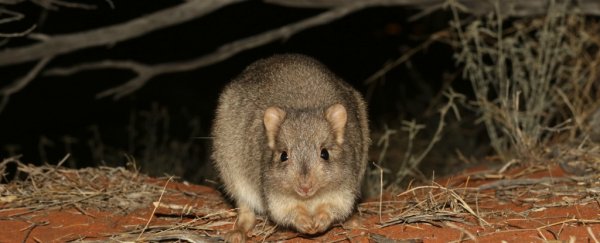In many places around the world, native animals have had their populations decimated by introduced species. Particularly in cut off lands like Australia, many species are now only found in isolated locations.
But researchers now think that there's a way to 'train' animals to be wary of these predators, so they are no longer easy targets in the wild.
"Australian native species have not evolved with cats and foxes and so have not learnt the behaviours that can help them avoid being killed," says lead researcher Katherine Moseby, from the University of New South Wales (UNSW) in Australia.
"This prey naivety is thought to be the reason why most efforts to reintroduce threatened species outside fenced reserves and islands fail."
The UNSW researchers used an Australian marsupial – the burrowing bettong (Bettongia lesueur) - to investigate how the population reacted after being re-introduced into an area with cats as predators.
The bettongs were once the most common macropodiform mammal (a suborder of marsupials including kangaroos) on the whole continent – found all across Australia – but now only live on off-shore islands, or in specially fenced off reserves.
"The idea for our study came from facing the reality that we are unlikely to ever completely eradicate cats and foxes from Australia," Moseby said.
"We decided to address the issue of prey naivety by exposing native animals to low densities of real introduced predators in the wild in an attempt to stimulate learning and natural selection."
The researchers took 352 burrowing bettongs and put them into a 26 kilometre square paddock with four male, de-sexed feral cats. As a control another group were placed in a similar paddock without cats.
Over 18 months the UNSW team investigated anti-predator behaviours such as how vigilant they were and how fast they fled when approached.
"Previous attempts to train animals to avoid predators have been carried out in laboratories or in captivity, with animals exposed to images, models or real predators. But these approaches rarely improve survival," says one of the researchers, Rebecca West, also from UNSW.
"We wanted to see if animals could be trained in the wild by controlling the numbers of predators so the native animals had a chance to learn without their population being wiped out."
The researchers understand this is the first time this type of experiment has been carried out in the wild, and unlike in captivity, the burrowing bettongs were learning effectively.
"We found that bettongs exposed to cats became harder to approach, displayed more hiding behaviour in traps and started to show increased wariness when feeding in comparison to the control group of bettongs," said West.
"Our results show that real predator exposure can change behaviour."
This is exceptionally good news for the team, but they are quick to point out that this isn't a magic solution.
"It might take many generations before predator exposure training will improve survival in the wild but our results suggest a positive step in the right direction to allowing our native threatened species to co-exist with introduced predators into the future," said West.
This study brings hope that eventually threatened animals such as the burrowing bettong would be able to be returned to their native habitats.
The research has been published in the Journal of Applied Ecology.
In the meantime, if you want to check out more footage of these cuties, the researchers have put together a video of the bettong monitoring which you can see below.
UNSW Science is a sponsor of ScienceAlert. Find out more about their world-leading research.
